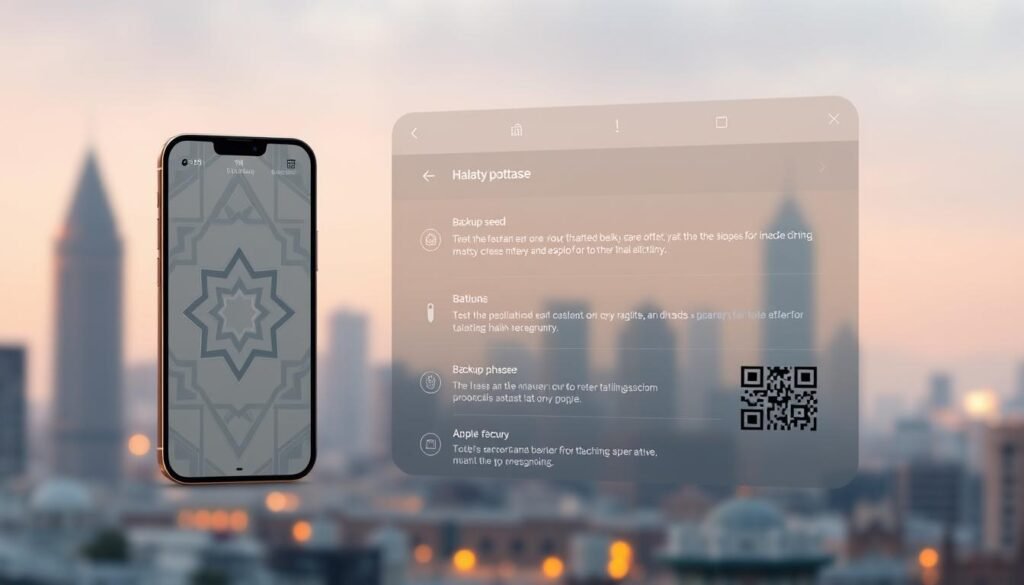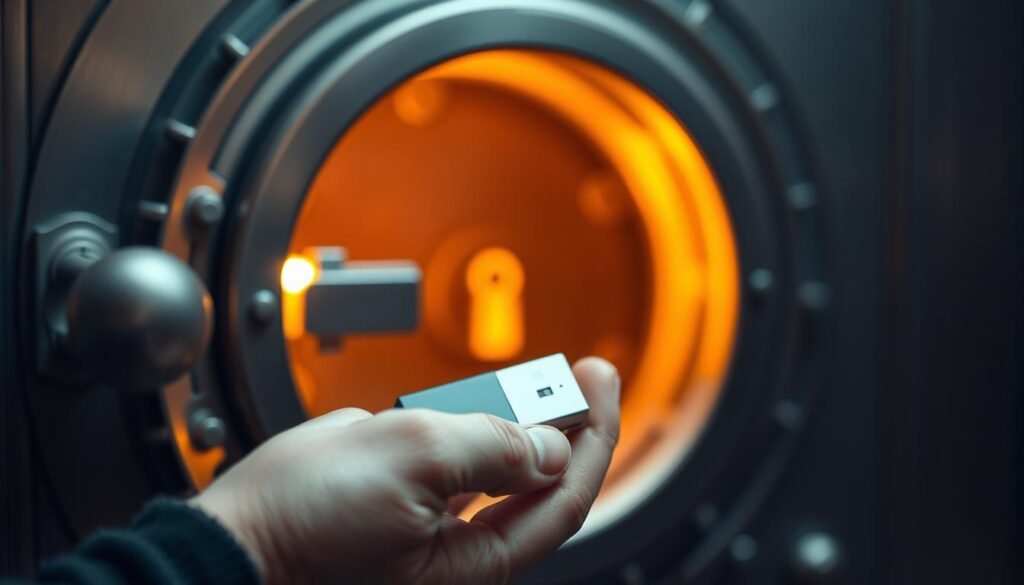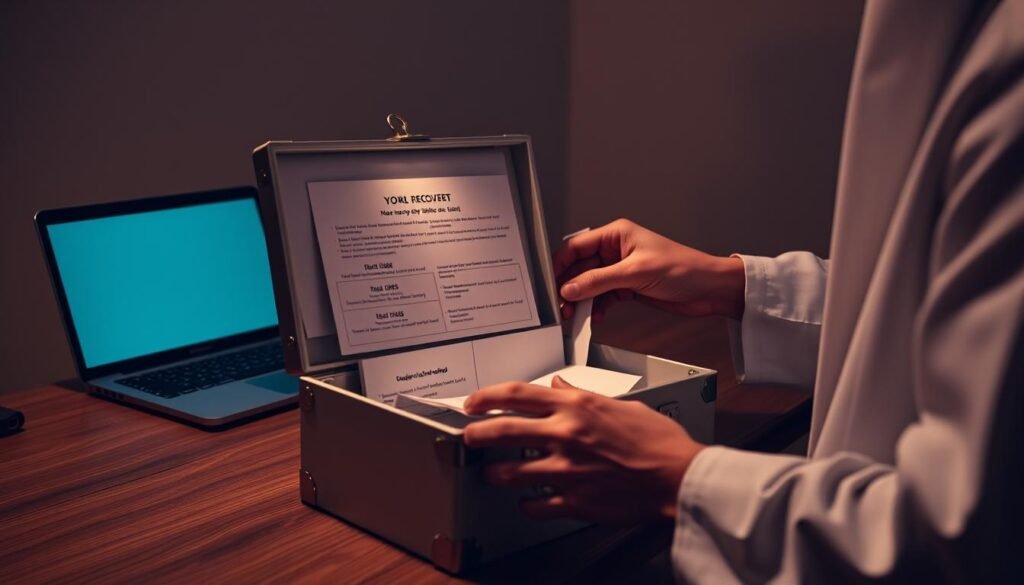Protecting your investments starts with one simple truth: if you lose access to your private keys, your funds disappear forever. In this regard, there is a pressing need for Muslim investor to get a hold of Halal Crypto Wallet Backup. Unlike traditional banking, there’s no customer service hotline to recover forgotten passwords or stolen devices. For those managing digital assets under Islamic financial principles, this responsibility becomes even more critical.
Consider this: Binance reports that roughly 20% of all Bitcoin—worth billions—is stranded in wallets nobody can access. These losses often stem from overlooked backup practices or misplaced security phrases. Non-custodial solutions put you in control, but that freedom demands careful planning.
This article simplifies safeguarding your holdings while aligning with ethical financial guidelines. We’ll break down methods to secure recovery phrases, compare storage options, and explain how proactive measures prevent irreversible losses. Whether you’re new to decentralized finance or refining your strategy, these steps ensure peace of mind without compromising values.
Key Takeaways
- Losing private keys means permanent loss of funds—no third party can restore access.
- Over 3.7 million Bitcoins are already stranded due to poor backup practices.
- Ethical investing principles require both financial and technical diligence.
- Multiple backup methods exist, from hardware storage to encrypted documents.
- Regularly updating security measures prevents vulnerabilities over time.
Understanding Halal Crypto Wallets and Backups
Modern financial tools require both technical awareness and moral alignment. For those prioritizing faith-based finance, selecting the right storage method involves more than just security—it demands adherence to specific ethical standards.

Core Principles of Faith-Aligned Storage
A faith-compliant storage solution avoids transactions involving interest (riba) and speculative risks. These systems verify transactions through blockchain technology while filtering prohibited activities. Your access codes remain private, ensuring full control without third-party interference.
Why Multiple Copies Matter
Losing a device shouldn’t mean losing your holdings. Secure duplication of recovery phrases protects against hardware failures or theft. Consider these methods:
| Storage Type | Security Level | Accessibility |
|---|---|---|
| Metal Plates | High (fire/waterproof) | Moderate |
| Encrypted USB | Medium | Easy |
| Paper Backup | Low | Immediate |
Over 60% of users who lose their holdings cite poor duplication practices as the cause. Regularly updating your storage locations prevents this. Always keep physical and digital copies separate for optimal protection.
Importance of Backing Up Your Crypto Wallet
Imagine your digital wealth vanishing in an instant—no recovery options, no safety nets. Unlike traditional bank accounts, decentralized systems don’t offer password resets or fraud departments. Your access codes act as both gatekeeper and potential liability.

Hardware glitches strike without warning. Phones get dunked in pools, laptops crash mid-update, and USB drives corrode. A single storage failure could lock you out permanently. That’s why duplicates matter—multiple copies stored separately keep your assets reachable through any compatible device.
Cyberattacks target holders daily. Hackers deploy sophisticated phishing schemes, while physical thefts compromise unprotected devices. Security experts note that 60% of compromised accounts lack proper recovery plans. With verified backups, you regain control even if criminals breach your primary access point.
Ever forgotten a password? Human error causes 25% of asset losses annually. “I thought I wrote it down somewhere” becomes a costly refrain. Decentralization means no institution will bail you out—your preparedness determines outcomes.
Regularly updated safeguards prevent obsolescence. Corrupted software or outdated formats won’t trap your holdings when you test restoration processes quarterly. This proactive approach transforms anxiety into confidence, letting you focus on growth rather than fear.
Identifying the Right Wallet for Halal Investments
Choosing where to store digital assets requires balancing faith principles with practical security. Different storage solutions offer varying levels of control and protection. Let’s explore options that align with ethical finance while keeping your holdings safe.

Custodial vs. Non-Custodial Wallets
Custodial options let exchanges manage your private keys. They’re handy for quick trades but mean trusting third parties with your assets. Many platforms offer shareable payment links, simplifying transfers. However, this convenience comes with risks—like phishing scams targeting exchange accounts.
Non-custodial systems put you in charge. You control the keys, ensuring compliance with self-managed ethical standards. This approach demands technical confidence but eliminates reliance on external services. When selecting secure storage solutions, prioritize transparency in transaction verification.
Hardware vs. Software Options
Physical devices like USB-style hardware wallets keep keys offline. They’re immune to malware and ideal for long-term storage. Though less convenient for daily use, they provide unmatched protection against digital threats.
Software alternatives run on apps or browsers. They’re perfect for frequent transactions but stay connected online. Balance these tools with cold storage methods to create layered security. Consider this comparison:
| Type | Security | Best For |
|---|---|---|
| Hardware | High | Large holdings |
| Mobile App | Medium | Daily spending |
| Desktop | Variable | Tech-savvy users |
Your choice depends on transaction habits and risk tolerance. Mixing both approaches often works best—use software for liquidity and hardware for savings.
Key Components of a Secure Crypto Wallet Backup
Your digital fortune hinges on three critical elements you can’t afford to ignore. These components form an unbreakable chain linking security to accessibility—one weak point risks everything.

Recovery Phrase and Seed Phrase Explained
Think of your recovery phrase as a master keychain. This series of 12-24 words—sometimes called a seed or mnemonic phrase—holds the blueprint to rebuild your entire wallet. When you first set up storage, these words appear like a lifeline. Write them wrong, and you’re locked out forever.
“A single misplaced word can render billions inaccessible,” notes blockchain developer Amir Rashid. The magic lies in standardization: this phrase works across compatible systems, letting you manage multiple assets through one secure sequence.
The Critical Role of Private Keys
While your seed phrase rebuilds the vault, private keys are the individual locks. Each unique alphanumeric code controls specific assets. Lose them, and you lose direct access—no second chances.
Here’s the connection: your recovery phrase generates all private keys. Store both securely, but prioritize the seed. Metal plates beat paper for durability, while encrypted digital copies add redundancy. Test restoration quarterly—peace of mind beats panic when devices fail.
Step-by-Step Instructions for Halal Crypto Wallet Backup
Safeguarding digital assets demands precision and methodical planning. Let’s walk through essential actions to preserve access while maintaining ethical standards.

 Learn How To Earn Halal DeFi Staking Rewards
Learn How To Earn Halal DeFi Staking Rewards
Exporting Your Private and Seed Phrases
Start by opening your storage interface. Navigate to Settings > Security and select “Export Recovery Details.” Double-check each character—even minor typos can lock you out permanently. Most systems require two-factor authentication at this stage for added protection.
Write down the 12-24 word sequence exactly as shown. Never screenshot or email these details. Blockchain developer Layla Ahmed warns: “Digital copies left in inboxes become hacker magnets.” Use pen and acid-free paper for initial transcription.
Organizing and Storing Your Backup File
Create multiple copies using diverse formats. Label each version with creation dates and wallet types. Consider this storage comparison:
| Storage Method | Durability | Accessibility |
|---|---|---|
| Stainless Steel Plate | 10+ years | Manual retrieval |
| Encrypted USB | 5-7 years | Quick access |
| Bank Vault | Maximum | Delayed access |
Update backups quarterly or after major transactions. Automated tools like CryptoSafe Pro offer encrypted cloud storage with scheduled updates. Always test restoration processes—peace of mind comes from proven reliability.
Guide to Halal Crypto Wallet Backup
Digital asset protection begins with choosing storage tools designed for resilience. Look for platforms offering multi-format export options and encrypted data packaging. These features ensure your restoration toolkit remains accessible through technological shifts.

Detailed Process of Creating a Backup
Initiate the safeguarding sequence through your storage interface’s security menu. Select “Generate Restoration Package” to produce a file containing access codes and transaction records. Double-check character accuracy—even one mistyped letter can derail future recovery attempts.
Distribute copies across diverse mediums using this approach:
| Storage Method | Ideal For | Risk Level |
|---|---|---|
| Biometric USB | Frequent access | Low |
| Fireproof Bag | Long-term storage | Minimal |
| Encrypted Cloud | Quick retrieval | Moderate |
Maintaining and Updating Your Backup
Schedule quarterly verification checks to confirm file integrity. Cybersecurity expert Nadia Kareem advises: “Test restoration on disposable devices to avoid exposing primary systems.” Update copies within 48 hours of major balance changes or software upgrades.
Track modifications using a simple log:
- March 5: Added new transaction addresses
- June 12: Upgraded cloud encryption
- September 8: Replaced aging hardware
Rotate physical storage locations annually while maintaining digital access through password managers. This layered strategy keeps your protection systems current without overwhelming effort.
Cloud Backup vs. Offline Storage: Pros and Cons
Digital security isn’t one-size-fits-all. Choosing between cloud systems and physical storage depends on your risk tolerance and accessibility needs. Let’s explore practical ways to balance convenience with ironclad protection.
Encrypting Your Backup Files
Before storing sensitive details anywhere, add an encryption layer. Tools like AES-256 turn your data into unreadable code without the right password. Even if someone accesses your files, they’ll hit a digital brick wall.
This step matters for both cloud and offline methods. A USB drive left in a drawer becomes useless to thieves when encrypted. Cloud storage providers often include encryption, but adding your own ensures double protection.
Best Practices for Cloud and Offline Storage
For cloud solutions, pick a provider with zero-knowledge protocols—they can’t view your data. Enable two-factor authentication and update passwords quarterly. Pair this with offline copies on fireproof media like stainless steel plates.
Store physical backups in separate locations—a home safe and a trusted relative’s house, for example. Test restoration processes annually to catch format changes early. Comparing secure storage options helps identify systems matching your ethical and technical needs.
Hybrid approaches work best. Use cloud for frequent access and offline methods for long-term safety. Update both whenever you modify holdings or security settings.








